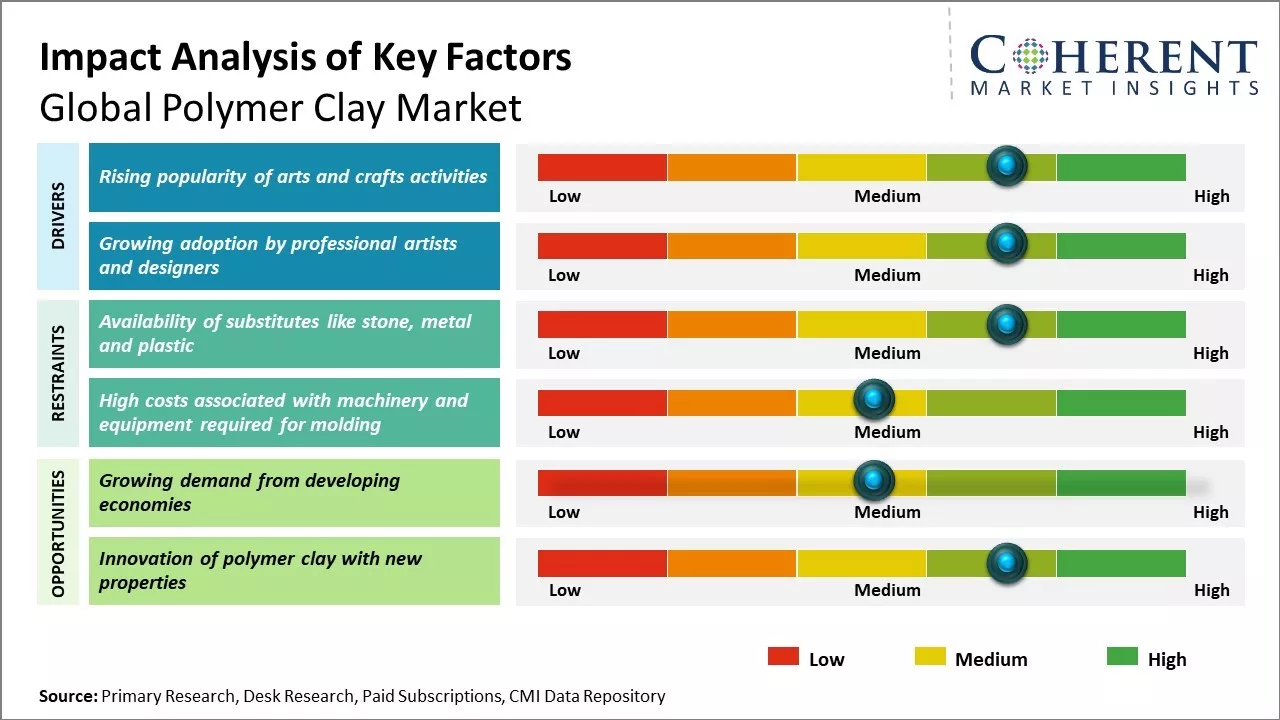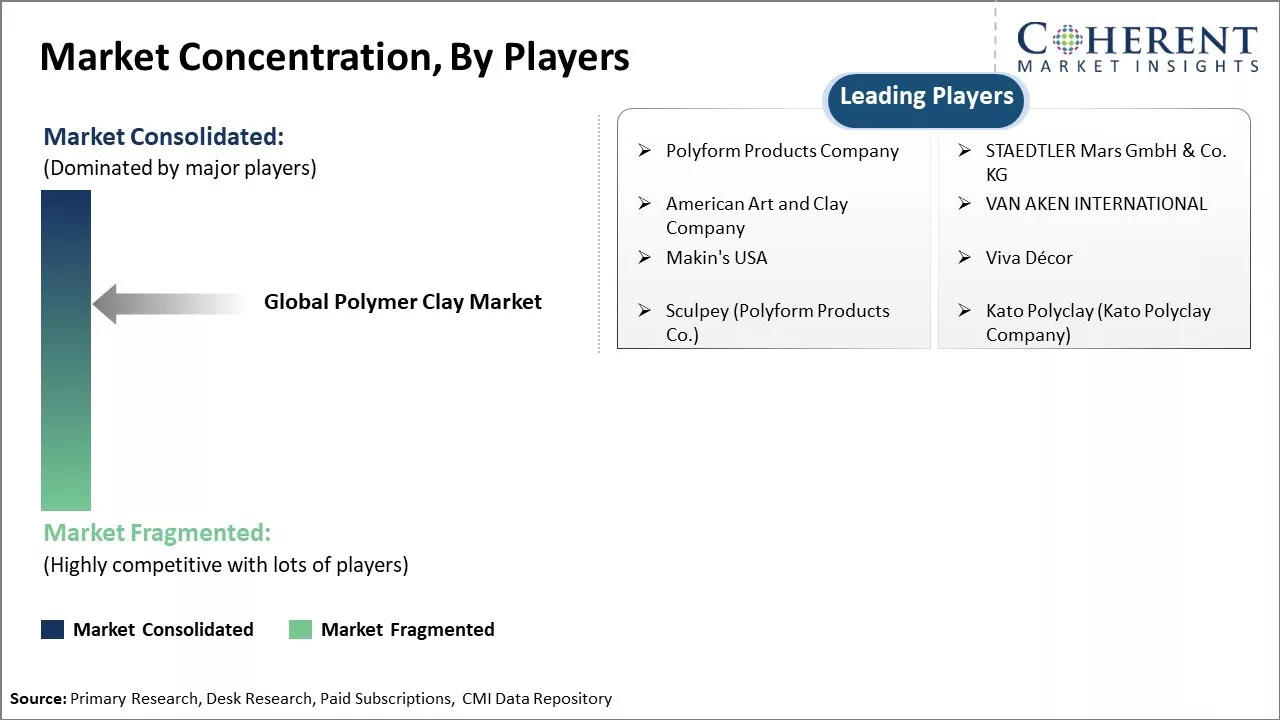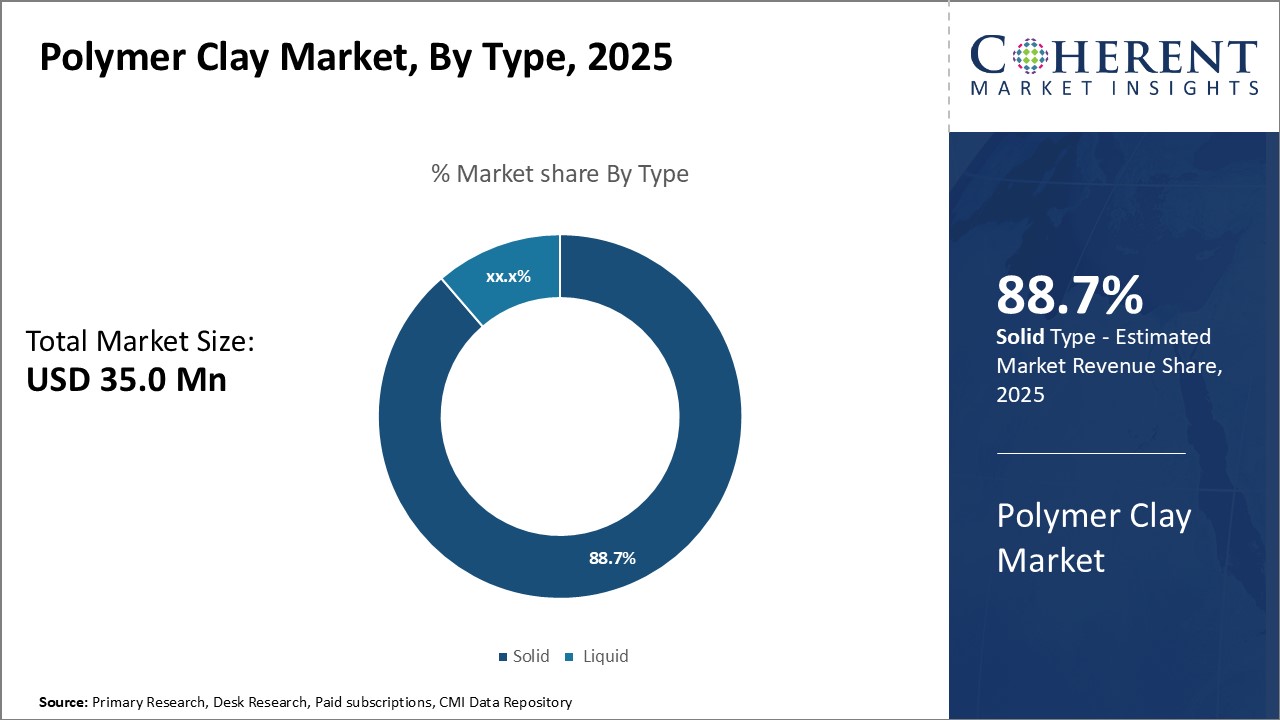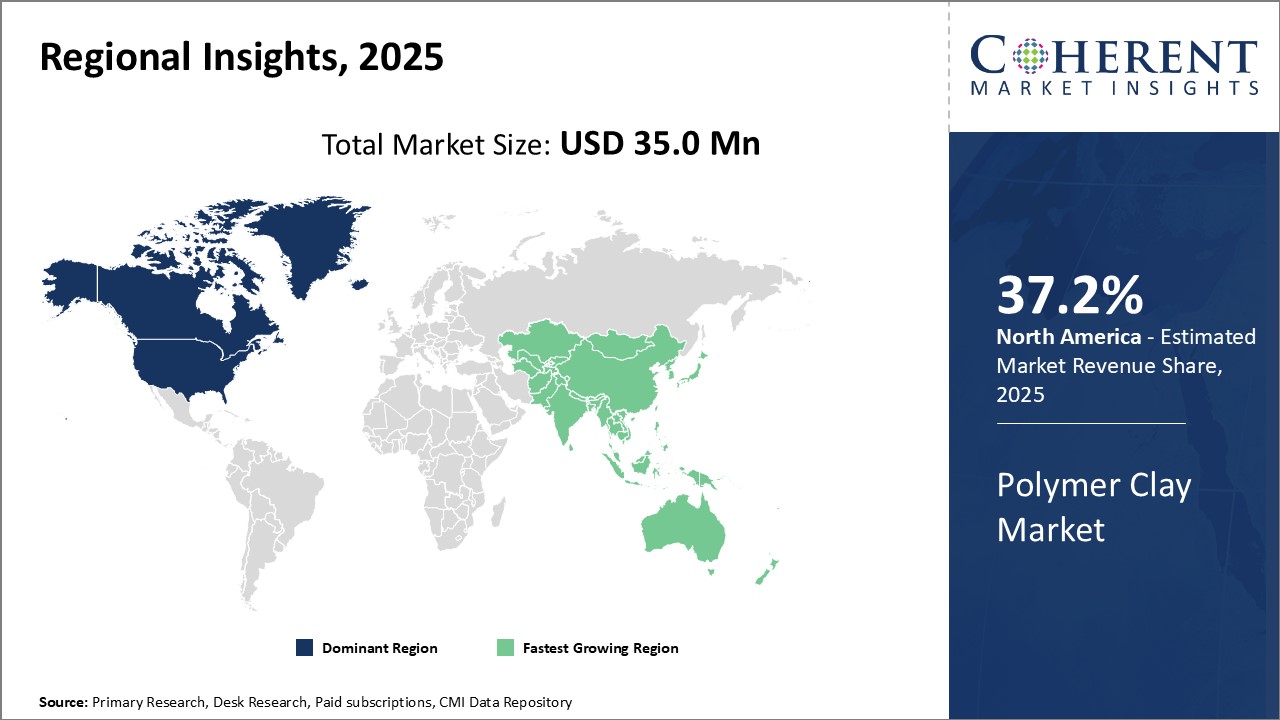Polymer Clay Market Size and Trends
The polymer clay market is estimated to be valued at USD 35.0 Mn in 2025 and is expected to reach USD 44.0 Mn by 2032, exhibiting a compound annual growth rate (CAGR) of 3.3% from 2025 to 2032.

Discover market dynamics shaping the industry: Download Free Sample
The polymer clay market is expected to witness positive growth over the forecast period. The increasing popularity of DIY activities and craft hobbies among individuals is supporting the growth of the polymer clay market. Polymer clay products are widely used in homemade accessories, jewelry making, figurines, and other decorative art objects. Rapid urbanization and rising disposable income levels in developing counties is also fueling the market growth. Furthermore, polymer clay can be molded into any shape and will retain its shape once baked. It is a non-toxic and kid-safe material encouraging its adoption among home hobbyists and teachers for educational art projects. However, availability of substitutes like ceramic clay and plasticene can hamper the market growth during the forecast period.
Rising popularity of arts and crafts activities
Polymer clay has gained widespread popularity among hobbyists and home artists over the past decade. The ease of use and versatility of polymer clay makes it a very accessible creative medium for both casual crafters as well as serious artists. Unlike traditional clay, polymer clay does not require firing in a kiln and hardens on its own at room temperature. This allows crafters to work on projects over multiple sittings and make refinements along the way before the clay permanently hardens.
The crafting scene has boomed in recent years with more people taking up activities like knitting, embroidery, scrapbooking, and jewelry making in their free time. Polymer clay jewelry in particular has emerged as a favorite creative outlet among home artists. Popular YouTube tutorials and Instagram trends have further spurred interest in arts and crafts and introduced polymer clay to many new enthusiasts. Crafters markets and DIY conventions are also attracting larger crowds every year, exposing more attendees to the possibilities of working with polymer clay.
The self-care and mindfulness benefits of creativity-based hobbies have further boosted the appeal of crafting activities. For busy professionals and parents, getting hands-on with polymer clay offers a relaxing stress-buster when they can carve out some personal time. The instant gratification of finishing small projects also makes polymer clay very rewarding to work with. With the growing popularity of the 'Maker Movement' that celebrates creativity, customization and self-sufficiency, more people are adding polymer clay to their toolkit to explore artistic designs. Overall, the increased interest in arts and crafts as a pastime is a major driver stimulating demand for polymer clay from hobbyists and home artists.
Market Concentration and Competitive Landscape

Get actionable strategies to beat competition: Download Free Sample
Growing adoption by professional artists and designers
Beyond the home crafts realm, polymer clay is also gaining prominence as a serious artistic medium. Once seen as just a kids’ material, polymer clay sculpts and works are now making their way into art galleries, museums, and high-end design studios. Established as well as emerging artists have started leveraging the unique characteristics of polymer clay to push creative boundaries in their craft.
A major factor working in favor of polymer clay’s rise among professionals is its versatility. Unlike stone or wood, polymer clay can be molded or sculpted with hands, tools, or cutting implements without putting undue pressure on the artist. It allows for intricate detailing, textures, and layering.
Key Takeaways from Analyst:
The polymer clay market presents several opportunities for growth driven due to rising craft activities and do-it-yourself culture. The market enjoys tailwinds from the increasing number of hobbyists and artists who are engaging with polymer clay to create various decorative items and accessories.
North America currently dominates the polymer clay market led by high crafting popularity in the U.S. The region is expected to remain the major revenue generator owing to the widespread availability of products and thriving artisanal and DIY trend. However, Asia Pacific is likely to emerge as the fastest growing market in the coming years. This can be attributed to the growing middle-class population and their increasing spending on creative hobbies in countries like India and China.
Higher prices of polymer clay compared to conventional mud clay could act as a restraint. Additionally, market players face challenges regarding product availability in rural areas where crafting is not very common. They need to expand distribution reach beyond tier-1 cities to further penetrate the market.
Market Challenges: Availability of substitutes like stone, metal and plastic
The availability of substitutes like stone, metal and plastic is presenting a notable challenge for the growth of the global polymer clay market. These alternative materials offer comparable functionality and creative design options to polymer clay at often lower price points. Stone, metal and plastic can all be sculpted, molded and crafted into artistic pieces, serving as direct alternatives for hobbyists and creative professionals otherwise inclined towards polymer clay. While polymer clay remains preferable for its soft, pliable qualities that aid in detailed modeling work, substitutes are limiting its potential for expansion into new customer segments.
Market Opportunities: Growing demand from developing economies
The rapidly expanding middle class population in developing economies of Asia and Latin America poses a huge growth opportunity for the global polymer clay market. Countries like India, China, Brazil, Mexico etc are witnessing rising disposable incomes and consumption abilities of their populations. Polymer clay products which were earlier considered as premium offerings for crafting & modeling activities are now becoming affordable artistic mediums for the masses in these emerging markets. With growing social media penetration and exposure to global hobby & craft trends, activities like sculpture making, jewelry designing, miniature modeling etc are seeing widespread adoption among the young population of these developing countries. Polymer clay accessories are finding new applications as personalized gifting items during festivals and occasions. Both individual hobbyists as well as small businesses involved in accessories & decor manufacturing have started utilizing polymer clay on a larger scale.

Discover high revenue pocket segments and roadmap to it: Download Free Sample
Insights by Type: Versatility and Durability Drive the Demand for Solid Polymer Clay
Within the polymer clay market segmented by type, solid polymer clay is expected to contribute 88.7% of the market share in 2025, due to its versatile applications and durable qualities. Unlike liquid clay which must be carefully molded and shaped while still wet, solid clay can be manipulated easily at any time by kneading or rolling. This makes it much more forgiving for crafters of all skill levels. Solid clay does not require special tools or experience with wet clay techniques. Users can stop and resume projects at their convenience without worrying about pieces drying out.
The solid texture also lends itself well to detailed sculpting and shaping. Fine details, textures, and smaller pieces are much easier to create from a solid rather than a liquid substance. This opens up solid polymer clay to a wide variety of artistic, sculptural, and miniature applications. Professional sculptors rely on solid clay for intricate figurines, dioramas, and architectural replicas. Hobbyists enjoy making decorative charms, miniature food items, and realistic animal sculptures.
Once cured, solid polymer clay maintains its shape indefinitely without cracking or warping. It is water resistant and durable enough for toys, figurines, and other handled objects. The material is a good choice for children's crafts since pieces will hold up against wear and tear. Jewelry made from solid clay can be worn every day without losing luster or compromising delicate designs over time. Solid clay's permanence allows crafters to create long-lasting gifts and collectibles that will stand the test of time. The adaptability and longevity of solid polymer clay satisfies both casual crafters and serious artists. Its versatility across creative applications has made it the dominant type found in the polymer clay market today. As interest grows in crafting, sculpting, and doll/miniature making as hobbies, solid clay will remain an essential material.
Insights by application: Arts and Sculpture Lead the Application Segment Due to Creative Flexibility
Within the polymer clay market segmented by application, arts and sculpture is expected to hold 40.3% of the market share in 2025. Polymer clay is uniquely suited to this wide range of creative expression through its manipulability and ability to take on fine detail. Unlike traditional art media such as paint, clay allows three-dimensional sculptures and shapes to be constructed. But unlike pottery clay, polymer clay is lightweight, easy to handle, and not susceptible to cracking or warping during the firing process.
Sculptors of all skill levels use polymer clay to bring characters, portraits, abstract designs, and others to life in vivid color and realism without advanced molding techniques. Amateur artisans enjoy sculpture as a relaxation and stress relief activity at their own pace in a far more forgiving material than natural clay. Polymer clay pieces require no special equipment and can be stored and displayed without the risk of damage. Within the sculpture field, polymer clay excels at miniature dioramas, figurines, replicas of famous artworks, and life-sized busts. Detail-oriented artists push the material's capabilities with painstaking recreations of costume jewelry, historical artifacts, architectural elements, and natural forms down to scales of just millimeters. For jewelry-makers as well, polymer clay becomes a medium as malleable as precious metals but far less costly to experiment with innovative designs.
Regional Insights

Need a Different Region or Segment? Download Free Sample
North America has dominated the global polymer clay market for many years owing to a strong industrial base and high consumption rates in the region. The region is expected to hold 37.2% of the market share in 2025. The presence of major manufacturers in the U.S. and Canada has enabled the easy availability of a wide range of polymer clay products at affordable prices. Additionally, the growing do-it-yourself (DIY) trend and popularity of craft activities among consumers has further boosted the market growth. Brands extensively focus on marketing their products via social media and online platforms to tap the massive audience interested in creative hobbies like pottery, jewelry making, miniature sculptures, etc. One of the key drivers for the polymer clay market in North America has been steady growth in enrollment for various art and craft related courses at colleges and skill development centers. Students and hobbyists are prominent consumers which keeps demands high. Furthermore, ongoing technological advancements have led to the development of new polymer clay variants with advanced properties like ultra-thin sheets for miniature work, glitter infused, liquid clay, etc. Such widespread availability of unique products tailored for specialized needs has augmented the market size.
The Asia Pacific region has emerged as the fastest expanding market for polymer clay globally. Rapid urbanization, rising disposable incomes, and growing interest of the young population in artisanal hobbies are major factors propelling the industry expansion. China, in particular, stands out with burgeoning manufacturing hub and huge domestic and export demand for polymer clay products. It has emerged as the leading importer as well as exporter. The presence of cost-effective raw material and labor has encouraged several multinational manufacturers to establish production bases in the country. Furthermore, ongoing infrastructure projects, real estate boom, and investment in educational institutes are providing continued impetus to the construction industry which utilizes polymer clay for tile adhesive, grouting, and masonry applications. Overall, Asia Pacific is anticipated to witness most prominent growth on the back of supportive macroeconomic trends and industry dynamics.
Market Report Scope
Polymer Clay Market Report Coverage
| Report Coverage | Details | ||
|---|---|---|---|
| Base Year: | 2024 | Market Size in 2025: | USD 35.0 Mn |
| Historical Data for: | 2020 To 2024 | Forecast Period: | 2025 To 2032 |
| Forecast Period 2025 to 2032 CAGR: | 3.3% | 2032 Value Projection: | USD 44.0 Mn |
| Geographies covered: |
|
||
| Segments covered: |
|
||
| Companies covered: |
Polyform Products Company, STAEDTLER Mars GmbH & Co. KG, American Art and Clay Company, VAN AKEN INTERNATIONAL, Makin's USA, Viva Décor, Sculpey (Polyform Products Co.), and Kato Polyclay (Kato Polyclay Company) |
||
| Growth Drivers: |
|
||
| Restraints & Challenges: |
|
||
Uncover macros and micros vetted on 75+ parameters: Get instant access to report
Polymer Clay Industry News
- In January 2024, Vesco launched clay extraction operations in the EU
- In 2023, Armourcoat launched a new clay lime plaster
*Definition: The polymer clay market consists of craft and modeling materials made from polyvinyl chloride (PVC) or polyester resin combined with plasticizers and pigments. Polymer clay is used by artists, crafters, and hobbyists to make decorative sculptures, jewelry, home accessories, and others through manufacturing techniques like molding, shaping, and baking. It hardens permanently through a polymerization process during heating and can be sanded, drilled, stained, or painted like pottery. The global polymer clay market has seen steady growth in demand from hobbyists as well as professional sculptors and designers.
Market Segmentation
- Type Insights (Revenue, USD Mn, 2020 - 2032)
- Solid
- Liquid
- Application Insights (Revenue, USD Mn, 2020 - 2032)
- Arts & Sculpture
- Jewelry
- Toys & Novelty
- Ceramic Products
- Others
- Regional Insights (Revenue, USD Mn, 2020 - 2032)
- North America
- U.S.
- Canada
- Latin America
- Brazil
- Argentina
- Mexico
- Rest of Latin America
- Europe
- Germany
- U.K.
- Spain
- France
- Italy
- Russia
- Rest of Europe
- Asia Pacific
- China
- India
- Japan
- Australia
- South Korea
- ASEAN
- Rest of Asia Pacific
- Middle East & Africa
- GCC Countries
- Israel
- Rest of Middle East & Africa
- North America
- Key Players Insights
- Polyform Products Company
- STAEDTLER Mars GmbH & Co. KG
- American Art and Clay Company
- VAN AKEN INTERNATIONAL
- Makin's USA
- Viva Décor
- Sculpey (Polyform Products Co.)
- Kato Polyclay (Kato Polyclay Company)
Share
Share
About Author
Vidyesh Swar is a seasoned Consultant with a diverse background in market research and business consulting. With over 6 years of experience, Vidyesh has established a strong reputation for his proficiency in market estimations, supplier landscape analysis, and market share assessments for tailored research solution. Using his deep industry knowledge and analytical skills, he provides valuable insights and strategic recommendations, enabling clients to make informed decisions and navigate complex business landscapes.
Missing comfort of reading report in your local language? Find your preferred language :
Transform your Strategy with Exclusive Trending Reports :
Frequently Asked Questions
EXISTING CLIENTELE
Joining thousands of companies around the world committed to making the Excellent Business Solutions.
View All Our Clients
